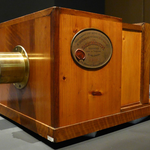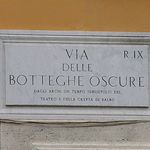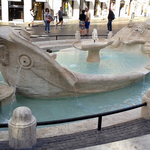Colosseo
It is considered to be a symbol of the eternal Rome. It is the biggest monument of the roman period and more famous for the austerity and the purity of its style.
Its name is taken from Latin "colosseus", "colossale" that meant the colossal statue of Nero depicted as the Sun god. With its 35 meters of the height it was the biggest bronze statue never accomplished. But its true name is Amphiteatrum Flavium since it was built by the Flavians who were an important roman family.
Vespasian started its construction in year 72 d.c . on the place of the drained stagnum, i.m. an artificial lake of Domus Aurea ( Nero's villa). The emperor wanted to return to the people the town part occupied by scandalously immense Nero's home.
It was finished and inaugurated in 80 by the son Tito with the celebrations which are considered to be up-to-now the greatest show of the world in the biggest amphitheatre of the world named the Colosseum. With the presence of 70 thousand Romans who came from all the parts of the Empire 5 thousand animals and 2 thousand gladiators died in combat during the show that lasted with no breaks days and nights within 100 days.
Under Domitian it was completed with the construction of the last flight of steps and an immense tent (velarium) handled by 100 sailors. The tent was to shield the spectators from the sun during the day while at night it was lit up by thousands of torches.
The magnificent monument has an elliptical form with the biggest axis of 188 meters and the smallest axis of 156 meters. Its circumference has 527 meters. The building is based on a platform of 13 meters thick while the huge perimeter reaches 57 meters. It has three superposed series of arches on pillars against which the semi columns in three classical Doric, Ionic, and Corinthian orders are laid. The building is encircled by the fourth order of a slender Corinthian pilaster strip against the masonry, which looks like a very high attic with little rectangular windows. At the second third of that order's height there is a crown of big equidistant brackets. They served as a support to the poles which were inserted into corresponding open holes in the last cornice and were supposed to sustain the Velario.
The Colosseum was built of more than 100.000 cubic meters of travertine blocks originally united by 300 tons of iron cramps. These cramps were pulled out in the Middle Ages leaving the holes with marble, tufo, bricks and concrete inside that one can see until now .
This is the "magic circle" as it was called by Byron is the biggest amphitheatre of the world.
Constructed within only 8 years it appeared to be a record of magnificence and organization. 70 thousand spectators can find their seats here or leave them in only 3 minutes through 80 entries. Inside the least axis there were two boxes one of each was reserved for the Imperial Family and the other one for the Vestals, the priests and the Magistrates while cavea was divided into dress-circles and 3 circular sectors which were flown by the nobles in the first sector, the citizens in the second sector, while in the third one and the highest one was occupied by the plebs.
Then there were other two sectors. The fourth of them was intended for the women with wooden seats and so the terrace for those who wanted to keep standing. The sector was accessible by means of the stairs. Under the arena the galleries were imposed for animals used in the hunting and in the tournaments which got set from the cells to the arena through corridors inclined boards and underground goods-lifts.
On the long axis there was the libitinaria door, from where the dead bodies were taken out.
For 400 years in the Colosseo the triumph of death was celebrated with the most various rites.
It is not historically proved that among various entertainments existed the one of eating the Christians by the wild beast. However the scene of praying virgins and apostles that were spouted into the arena facing the death was transmitted to us through ancient mosaics and the culminating point of famous novels like Quo Vadis and the main scene of the Ben Hur film.
The Belgian priest father Delahaye claims that the Christians were martyrized but not in the Colosseum.
Many legends were invented about the Colosseum in the Middle Ages.
The famous one is of Venerando Beda (VII-VIII century) who said: "While the Colosseum stands Rome will stand too". When the Colosseum falls down Rome will finish too but when Rome finishes the world also will finish".
In the year 404 by Onorio's decree the fights between gladiators were abolished and in the VIth. d.c. the tournaments with animals were abolished too.
The earthquakes of 442, of 508 and particularly of 851 caused destructions and the fall of two orders of arches. It was restored several times by popes Pio VII, Leon XII, Gregorio XVI and Pious IX as it is approved by numerous inscriptions on the spot. Damaged from other earthquakes of 1231, 1255 in 1349 it was transformed into fortress by the Frangipane family and then passed to the Hanibal while in 1312 Enrico VII passed it to the Senate and the Roman people. The fallen boulders were used for building of palaces and well-known roman state edifices up to the XVII century when by the initiative of pope Benedict XIV in 1740 the Colosseum was consecrated to Jesus Passion declaring it holy for the blood poured by the martyrs. According to the tradition accepted in that time the gigantic cross was raised up here.
The real conservative interventions were to initiate in the end of '800, the last one was started in 1992.

 The records of Rome. Big numbers, not always enviable, for a big city.
The records of Rome. Big numbers, not always enviable, for a big city. New Phot-O-Matic section. To spend some time looking at photos (also) of Rome.
New Phot-O-Matic section. To spend some time looking at photos (also) of Rome. The administrative, urban, toponymic and imaginative subdivisions of Rome.
The administrative, urban, toponymic and imaginative subdivisions of Rome. Notice for tourists: in Rome you drink for free. Historical fountains and 'big noses'.
Notice for tourists: in Rome you drink for free. Historical fountains and 'big noses'. Free museums return on the first Sunday of the month.
Free museums return on the first Sunday of the month.